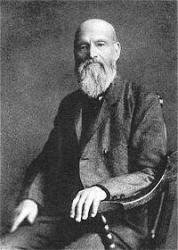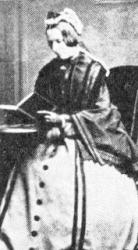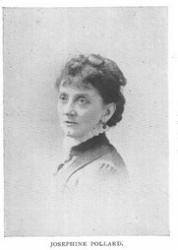Planning worship?
Check out our sister site, ZeteoSearch.org,
for 20+ additional resources related to your search.
- |
User Links
Person Results
‹ Return to hymnal




Export as CSV
Erastus Johnson

1826 - 1909 Hymnal Number: d88 Author of "O then to the Rock let me fly" in The Garner Johnson, Erastus. (April 20, 1826--June 16, 1909, Waltham, Massachusetts). This man whose life was singularly active and varied was born in a logging camp at Lincoln, Maine. He was buried in Jackson, Maine. He entered the Academy at Calais, Maine, at the age of fifteen, spent two years there, taught school for the next six, and then entered Bangor Theological Seminary. His health failed, and, threatened with the loss of his sight, was compelled to give up preparation for the ministry. On the advice of his physician he took a sea voyage, embarging on the ship Gold Hunter en route from New York to California. The crew of the ship mutinied just before rounding Cape Horn and as Johnson was the only person on board who knew anything about navigation, other than the captive officers, he was pressed into service to take the ship on to its destination, San Francisco. This he was able to do successfully. Not a seeker after California's newfound gold, he was, variously, a rancher in California, a farmer in Washington state, in the oil business in Pennsylvania for some twenty years, and again a farmer in Maine until his retirement in Waltham, Mass. As ardent Methodist, always interested in religious work, especially in the Y.M.C.A., he was a lifelong student of the Bible, a fluent speaker, and a musician of moderate attainment. He published one book of poems, most of which were of interest only to members of his immediate family.
Sources: Correspondence with Mrs. Julia Johnson Howe, daughter of the subject of this sketch; Our Hymnody, Robert G. McCutchan; Hymns of Our Faith, Reynolds.
--Robert G. McCutchan, DNAH Archives
Erastus Johnson
Elizabeth Codner

1824 - 1919 Hymnal Number: d73 Author of "Even me, even me" in The Garner CODNER, Elizabeth (née Harris) was born in Dartmouth, Devon in 1823. Croydon, Surrey, 28 March 1919. She was interested in the mission field from an early age, and two of her early publications were entitled The Missionary Ship (1853) and The Missionary Farewell (1854) relating to the Patagonia Mission (later the South American Missionary Society). She married William Pennefather at the Mildmay Protestant Mission in London, and edited the mission’s monthly Woman’s Work in the Great Harvest Field. At age 17, she was editing a magazine for the Patagonia Mission, later the South American Missionary Society. She died in Croydon, Surrey on 28 March 1919.
NN, Hymnary
Elizabeth Codner
William Hammond
1719 - 1783 Hymnal Number: d74 Author of "Lord, we come before thee now" in The Garner Hammond, William, B.A, born at Battle, Sussex, Jan. 6, 1719, and educated at St. John's College, Cambridge. In 1743 he joined the Calvinistic Methodists; and in 1745, the Moravian Brethren. He died in London, Aug. 19, 1783, and was buried in the Moravian burial-ground, Sloane Street, Chelsea. He left an Autobiography in Greek, which remains unpublished. His original hymns, together with his translations from the Latin, were published in his:—
Psalms, Hymns, and Spiritual Songs. To which is prefix'd A Preface, giving some Account of a Weak Faith, and a Full Assurance of Faith; and briefly stating the Doctrine of Sanctification; and shewing a Christian's Completeness, Perfection, and Happiness in Christ. By William Hammond, A.B., late of St. John's College, Cambridge. London: Printed by W. Strahan; and sold by J. Oswald, at the Rose and Crown in the Poultry, mdccxlv.
A few of his original hymns from scriptural fidelity and earnestness have attained to a foremost position amongst English hymns. These include, "Awake, and sing the song," and "Lord, we come before Thee now." His translations of Latin hymns were amongst the earliest published after those contained in the Primers and other devotional works of 16th and 17th centuries. They are of merit, and worthy of attention. Greater use might also be made of his original compositions. In addition to those named above, the following are also in common use:—
1. Brightness of the Father's Face. God the Son.
2. How great the Christian's portion is. Possession of All in Christ.
3. If Jesus is yours. God's unchangeable Love.
4. In Thine own appointed way. Divine Worship.
5. Jesus, Who died the [a] world to save. Easter.
6. Lord, if on earth the thought of Thee. Heaven anticipated.
1. Now with joint consent we sing. Divine Worship.
8. O Lord, how little do we know. Quinquagesima.
9. Would you win a soul to God ? The Gospel Message.
--John Julian, Dictionary of Hymnology (1907)
William Hammond
H. L. Hastings

1831 - 1899 Person Name: Horace L. Hastings Hymnal Number: d105 Author of "Shall we meet beyond the river, where the surges" in The Garner Hastings, Horace Lorenzo, was born at Blandford, Mass., Nov. 26, 1831; commenced writing hymns, and preaching, in his 17th year, and laboured as an evangelist in various parts of the U. S. In 1866 he established The Christian, a monthly paper, in which many of his hymns have appeared, and in 1865 the Scriptural Tract Repository in Boston. He published Social Hymns, Original and Selected, Boston, 1865; Songs of Pilgrimage, a Hymnal for the Churches of Christ, Part i., 1880; and in August, 1886, the same completed, to tho extent of 1533 hymns, 450 of which are original and signed "H." The best known of these is "Shall we meet beyond the river," written in N. Y. city, 1858, and lately published as a leaflet in 14 stanzas of 8 lines. The text in Gospel Hymns and elsewhere consists of the 1st half of stanzas i., iv., xi. and ix. The Hastings Birthday Book, extracts from his prose writings, appeared 1886. [Rev. F. M. Bird, M.A.]
-- John Julian, Dictionary of Hymnology
H. L. Hastings
William H. Clark
1854 - 1925 Hymnal Number: d103 Author of "Come to the Royal Fountain" in The Garner Clark, William Henry. (Racine, Wisconsin, April 8, 1854--November 8, 1925, Rome, New York). Free Methodist. In his infancy, his parents returned to their former home in New York State, where his mother soon died, and his father married a close friend of hers, who forecast, after William's conversion in 1873, that one day he would be a bishop. He served the Susquehanna Conference of his denomination as a pastor and district superintendent from 1876 until 1919, when his stepmother's prediction came true. Meanwhile, he had been a member of the joint commission of the Free and Wesleyan Methodist Churches which compiled the Hymnal of 1910, and contributed some items to it. He died in office, requesting no eulogy at his funeral.
--Arlene Clyde, DNAH Archives, rev. Hugh McKellar
William H. Clark
Josephine Pollard

1834 - 1892 Person Name: Josepine Pollard Hymnal Number: d127 Author of "Let us seek salvation today" in The Garner Josephine Pollard USA 1834-1892. Born at NYC, NY, one of seven children and daughter of an architect, she attended an exclusive girls school, Spingler Institute, and was a lifelong member of the Presbyterian Church. She was a founding member of the professional women’s club, Sorosis. She never married. She became an author, poet, and hymnist, writing many children’s books and for children’s magazines, including Harper’s, Scribner’s, and the New York Ledger. She wrote 44 books, mostly religious, for children, but also about history, birds, sports and games, and adventure stories. She also wrote 100+ hymn lyrics as well. She worked as an editor for the Sunday School Times and for the Methodist Book Concern, where she edited a magazine for African Americans. Her children’s books include: “History of the U.S.” (1884); “The life of George Washington” ; “The life of Christ for young people”; “History of the New Testament in words of one syllable” (1899); “History of the Old Testament in words of one syllable” (1899); “Bible stories for children” (1899). She was in poor health in her latter years. She died at NYC, NY.
John Perry
===============
Pollard, Josephine, born in New York, circa 1840, is the author of (1) "I stood outside the gate" (Lent), (2) "Joy-bells ringing, Children singing" (Joy) in I. D. Sankey's Sacred Songs and Solos, 1878.
--John Julian, Dictionary of Hymnology, Appendix, Part II (1907)
Josephine Pollard
George Heath
1745 - 1822 Hymnal Number: d80 Author of "My soul be on thy [your] guard" in The Garner Rv George Heath DD United Kingdom 1745-1822. Born at Exeter, Devon, England, he was educated at the Dissenting Academy and King’s College, Cambridge. He married Mary Ann Kean, and they had 4 children: Louisa, John, Charles, and Benjamin (also a minister). He served as pastor of the Honiton, Devonshire, Presbyterian Church, but proved unworthy and was dismissed for cause. He later became a Unitarian minister. In 1781 he published “Hymns & poetic essays sacred to the worship of the Deity”. He also authored a “History of Bristol”. He became Headmaster of Eton College (1792-1802). He joined the Anglican Church and became Canon of Windsor (1800-1822), Rector of Monks Risborough, Vicar of Sturminster Marshall, Dorset, Vicar of Piddletown, Vicar of East Beachsworth (1805-1814), and Fellow of the Royal Society (1795-1822). He was appointed to the 4th stall in St. George’s Chapel in 1800, Windsor Castle, and died at his residence in the Cloisters, Windsor Castle.
John Perry
=======================
Heath, George, became pastor of a Presbyterian Church at Honiton, Devon, in 1770, and died in 1822. He published a History of Bristol, 1797. Also Hymns and Poetic Essays Sacred to the Public and Private Worship of the Deity, &c, Bristol, 1781, from which "My soul, be on thy guard" (Steadfastness), is taken.
--John Julian, Dictionary of Hymnology, Appendix, Part II (1907)
George Heath
Emily Sullivan Oakey
1829 - 1883 Person Name: Emily S. Oakey Hymnal Number: d109 Author of "Sown in the darkness or sown in the light" in The Garner A graduate of Albany Female Academy in New York. Taught rhetoric, composition, and foreign languages there for 24 (or 25) years. Contributed to at least 11 magazines. Published a book of poetry, At the Foot of Parnassus.. Wrote the hymn, “Sowing the Seed” in 1850. Originally published in “a western paper,” altered as it traveled from hand to hand. Popularized by Ira Sankey. Published in Gospel Hymns and Songs. Frequently requested from Edison Records, and recorded by them in 1904. According to Sankey, she was “a frail, delicate woman, always an invalid,mnever having known, as she once said, an hour of health in all her life.”
E. Adams
Sources:
Sankey, Ira D. My Life and Sacred Songs (1906), 138-143, 281-284.
Moore, Wendell. The Edison Phonograph Monthly (Mar 1904- Feb 1905), 8.
Library of Congress. Catalog of Copyright Entries Part 3: Musical
Compositions, Vol. 16, Part 2, Nos. 8-13 (Washington, D.C.: 1921), 1512.
Oakey, Emily S. At the Foot of Parnassus (Albany: 1883), 45-46.
Abbott , Edward and Madeline Vaughan Abbott Bushnell. The Literary World: A
Monthly Review of Current Literature, Vol. X (Boston: 1879), 63.
Munsell, J. Circular and Catalogue of the Albany Female Academy (1870), 2.
Exercises of the Alumnae of the Albany Female Academy (1880), 12-14.
Historical Sketch of the Albany Female Academy (1884), 19.
Butterworth, Hezekiah and Theron Brown. The Story of the Hymns and Tunes
(New York: 1906) 435-436. Archive.org.
Emily Sullivan Oakey
M. H. McKee
1879 - 1955 Hymnal Number: d135 Author of "He will gather the wheat in his garner" in The Garner Martin Hall McKee, known as Mark, born in Texas, died in Texas
Dianne Shapiro, from Find a Grave website (accessed 6/20/2022)
M. H. McKee
Eliza Holmes Reed
1794 - 1867 Person Name: Eliza Reed Hymnal Number: d83 Author of "[O] Why not tonight" in The Garner Reed, Eliza, née Holmes, was born in London, March 4, 1794; married to the Rev. Andrew Reed in 1816; and died July 4, 1867. Mrs. Reed entered fully and earnestly into her husband's extensive charitable works. Her publications include Original Tales for Children; and The Mother's Manual for the Training of her Children, 1865. Her hymns, 20 in all, were contributed to her husband's collection, and were republished with his in the Wycliffe Chapel Supplement, 1872. They are only of average merit, and have not attained to a marked position. They include:—
1. Gracious Lord, as Thou hast bidden. Holy Baptism.
2. I would be Thine, 0 take my heart . Dedication of Self to Christ.
3. 0 do not let the word depart. The Accepted Time.
4. 0 that I could for ever dwell. Communion with God Desired.
--John Julian, Dictionary of Hymnology (1907)
Eliza Holmes Reed


 My Starred Hymns
My Starred Hymns


